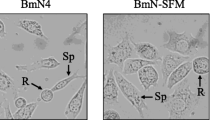Summary
HEP Flury strain of rabies virus was propagated in chick embryo cells under maintenance media of different pH. It was found that viral growth was better and reached a markedly higher maximum titer when the initial pH of maintenance medium was 8.2 to 9.0 than when it was 7.4. The enhancement of viral growth was not ascribable to mere neutralization of acids produced from infected cells, because the different media became almost equally neutral within an early phase of growth curve. Serial passage of the virus in chick embryo cells using pH 8.2 maintenance medium resulted in altered growth characteristics of the progeny virus; first, the virus so passaged could now grow equally well under alkaline and neutral maintenance media, and, secondly, autointerference observable with the parent virus tended to disappear. Serial undiluted passage of the parent as well as the progeny virus eventually lowered virus yield when neutral maintenance medium was used, but this effect of undiluted passage was eliminated by the use of pH 8.2 maintenance medium.
Similar content being viewed by others
References
Yoshino, K., S. Taniguchi, andK. Arai: Plaque assay of rabies virus in chick embryo cells. Arch. ges. Virusforsch.18, 370–373 (1966).
Yoshino, K., andT. Morishima: An improvement in the plaque assay of rabies virus in chick embryo cells. Arch. ges. Virusforsch.34, 40–50 (1971).
Koprowski, H., J. Black, andD. J. Nelsen: Studies on chick-embryo-adapted rabies virus. VI. Further changes in pathogenic properties following prolonged cultivation in the developing chick embryo. J. Immunol.72, 94–106 (1954).
Kondo, A.: Growth characteristics of rabies virus in primary chick embryo cells. Virology27, 199–204 (1965).
Crick, J., andF. Brown: An interfering component of rabies virus which contains RNA. J. gen. Virol.22, 147–152 (1974).
Dulbecco, R., andM. Vogt: Plaque formation and isolation of pure line with poliomyelitis viruses. J. exp. Med.99, 167–182 (1954).
Taniguchi, S., andK. Yoshino: An analysis of the plaque assay of herpes simplex virus in chick embryo monolayers. Arch. ges. Virusforsch.14, 537–552 (1964).
Matsumoto, S., andA. Kawai: Comparative studies on development of rabies virus in different host cells. Virology39, 449–459 (1969).
Yoshino, K., N. Kuma, A. Kondo, andM. Kitaoka: Infection of the one-day old fertile hen's egg with rabies virus. I. Growth curves and serial passages. Jap. J. med. Sci. Biol.9, 259–271 (1956).
Yoshino, K., S. Taniguchi, andK. Arai: Autointerference of rabies virus in chick embryo fibroblasts. Proc. Soc. exp. Biol. (N. Y.)123, 387–392 (1966).
Author information
Authors and Affiliations
Additional information
With 4 Figures
Rights and permissions
About this article
Cite this article
Yoshino, K., Kishie, T., Hashimoto, M. et al. Effect of alkaline maintenance medium upon the growth of rabies virus in chick embryo cells. Archives of Virology 47, 31–38 (1975). https://doi.org/10.1007/BF01315590
Received:
Issue Date:
DOI: https://doi.org/10.1007/BF01315590




